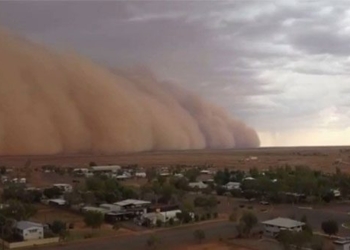Climate change is causing temperatures to rise, making heatwaves more frequent and intense. Factors like humidity and extreme weather are testing the limits of the human body.
In 2022, as severe heat struck India, Pakistan, Bangladesh, Nepal, and Sri Lanka, New Delhi recorded a record temperature exceeding 49 degrees Celsius. According to estimates, 90% of India’s 1.4 billion population was severely affected in terms of health or economics during this heatwave.
This year, experts have issued warnings about extreme weather for many regions in India coming this June – bad news for the power grid, crops, and hundreds of millions of workers. Abnormally hot and dry weather is expected to also wreak havoc this summer in Europe.

Residents cooling off during a severe heatwave in New Delhi, India. (Photo: AFP/TTXVN).
1. What Makes Extreme High Temperatures Dangerous?
There are many reasons. Humans are more prone to dehydration at high temperatures, increasing the risk of heart attacks and strokes. High heat can exacerbate respiratory issues, especially in areas with high pollution levels.
The stress from extreme heat also makes it harder for people to work and increases the risk of injury. It is difficult to accurately know how many people die from heat every year, as most cases go unrecorded.
There are no official figures on the damage caused by wildfires in India and Pakistan in 2022, but the initial report of 90 deaths is certainly too low. Emerging economies are hit harder than developed ones, as they often lack adequate respite from the sun. Most people work outdoors, while indoor spaces are not effectively cooled. Concrete and asphalt in urban environments can absorb heat, raising nighttime temperatures and contributing to heat stress.
Women and the elderly are believed to be the most affected according to a 10-year study on extreme heat phenomena conducted in Hong Kong, China.
2. What is a Wet Bulb Thermometer?
Forecasters are increasingly using various measures to assess heat stress and discomfort – such as humidity, heat index, or apparent temperature – to better understand the health risks posed by high temperatures. A wet bulb thermometer is one of these measures. This index represents the lowest temperature that an object can cool itself to when evaporation occurs. It accounts for the effects of humidity, making it challenging for the human body to cool itself by sweating.
For example: If it is 42 degrees Celsius with 40% humidity – like in Phoenix, Arizona, in July – the wet bulb temperature is about 30 degrees Celsius. A lower temperature, such as 38 degrees Celsius, but with higher humidity at 80%, will yield a wet bulb temperature of about 35 degrees Celsius. That temperature is high enough to cause heat exhaustion even in healthy individuals, regardless of shade and unlimited access to drinking water. In reality, shade and drinking water are often restricted, and heat can be deadly at much lower wet bulb temperatures.
A 2020 study published in the journal Science revealed that areas affected by the heatwaves in Europe in 2003 and in Russia in 2010, which caused thousands of deaths, had wet bulb temperature values that did not exceed 28 degrees Celsius.

A pedestrian covering their head to avoid the heat in Amritsar, India. (Photo: AFP/TTXVN).
3. How is Wet Bulb Temperature Measured?
Initially, a wet cloth is wrapped around a thermometer. Scientists record the temperature after the cooling effect of evaporation, similar to how the body cools itself by sweating. Now, wet bulb temperatures are measured using electronic devices at weather stations. More in-depth studies are supported by satellite data from sources such as the National Aeronautics and Space Administration (NASA) and the International Space Station (ISS).
The National Oceanic and Atmospheric Administration (NOAA) in the U.S. has also developed a more advanced tool for predicting heat stress, global wet bulb temperatures, factors affecting wind speed, solar angle, and cloud cover.
4. Where is Wet Bulb Temperature Important?
Traditionally, the highest temperatures and humidity levels are found in South Asia and subtropical climates. Some areas in India experience wet bulb temperatures exceeding 32 degrees Celsius. The United Nations predicts that this will be one of the first countries to surpass a wet bulb temperature of 35 degrees Celsius.
A new form of El Niño is pushing the mercury on thermometers to unprecedented levels in the region. Pakistan, the Middle East, and Mexico are also likely to experience high temperatures and humidity.
However, more and more places, particularly temperate regions, are witnessing extreme heat days. The UK recorded a record temperature of 40.3 degrees Celsius in July 2022, and Portugal reached 47 degrees Celsius, but the relatively low humidity in both locations kept the wet bulb temperature around 25 degrees Celsius.
Spain and Portugal recorded their hottest April on record in 2023 when a heatwave brought temperatures close to 40 degrees Celsius in some areas at the end of the month. This heatwave occurred amidst widespread drought affecting the region for the second consecutive year.
5. What are the Economic and Social Impacts?
In areas with extreme high temperatures, every aspect of life becomes more challenging and inequality worsens, especially in cities. But even cooler places feel the impact of the heat, primarily due to higher energy and food prices.
For instance, the scorching summer of 2022 in India reduced wheat production and forced this second-largest global producer to ban exports. This raised concerns about global food shortages and inflation amid the war in Ukraine, even though India is not a major exporter. This concern may repeat itself this year, affecting wheat, canola, and lentils. Electricity consumption also spikes during peak heat periods, stressing the power grid and consumers’ wallets as prices soar. High temperatures also exacerbate droughts, further stressing hydroelectric and nuclear power production.
6. How are Extreme High Temperatures Related to Climate Change?
Heatwaves are most directly related to human greenhouse gas emissions. And heat, along with drought and wind, causes wildfires. That is why scientists now believe that climate change is exacerbating wildfires in the Western United States, Australia, and elsewhere. The wildfire season in the U.S. is lasting more than two months longer than it did in the 1970s and 1980s.
Global warming is making tropical cyclones, also known as hurricanes, more intense. Warmer water and more humid air – two results of global warming – provide additional fuel for such storms. In India and Pakistan, extreme high temperatures are likely to occur 30 times more frequently due to climate change.




















































